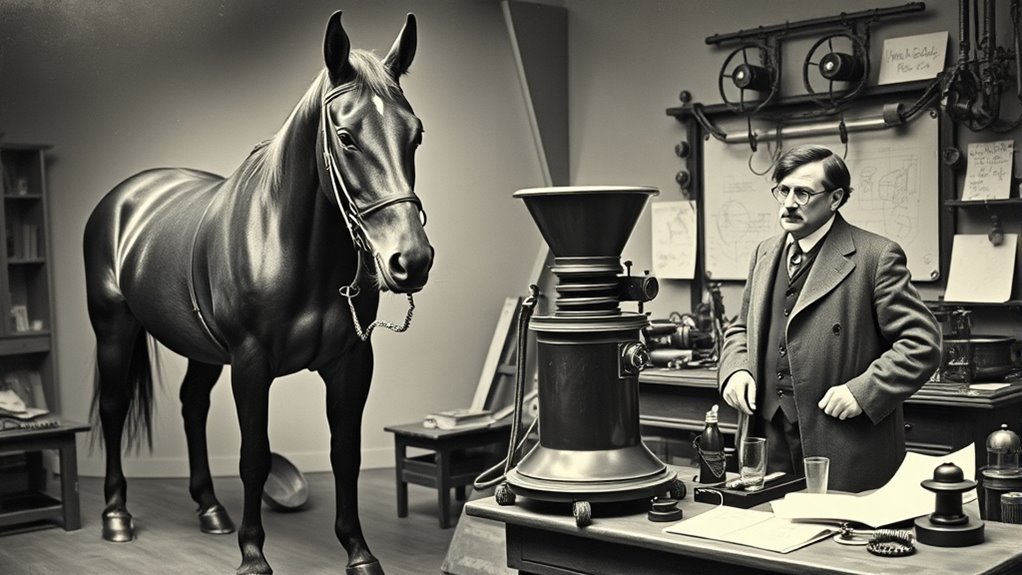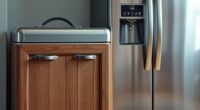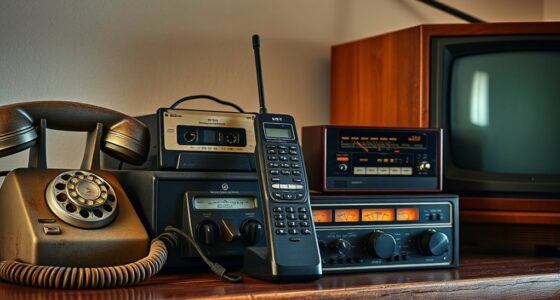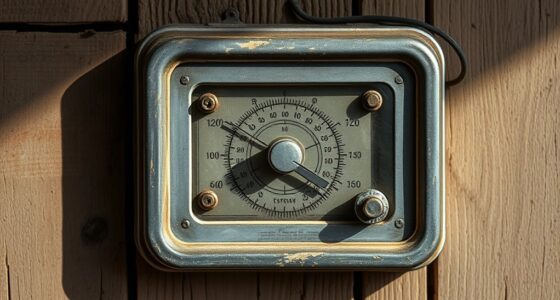You might be surprised to learn that the history of vacuum cleaners involves horse-powered devices from the late 19th century, aiming to reduce human effort. These early machines used horses to turn large suction systems attached to carts, creating a bizarre connection between animals and household cleaning. This quirky experiment laid the groundwork for modern innovations, from electric handheld models to smart robotic vacuums. Stick around to discover how these strange beginnings led to the advanced cleaners we use today.
Key Takeaways
- Early vacuum experiments included horse-powered devices to reduce manual effort in cleaning.
- Large suction apparatuses were attached to carts and powered by horses via belts and pulleys.
- Horsepower was exaggerated in marketing, linking animal strength to vacuum cleaning power.
- These quirky experiments highlight unexpected animal influences on vacuum development.
- The bizarre use of horses reflects the inventive, sometimes humorous, attempts to mechanize cleaning.
The Origins of Cleaning Devices: From Brooms to Early Machines

Cleaning devices have come a long way, starting with simple tools like brooms that have been used for centuries. Historical cleaning myths often suggest that ancient civilizations believed sweeping away dirt could also remove bad spirits, reflecting cultural cleaning rituals. These rituals weren’t just about hygiene but also spiritual cleansing, emphasizing cleanliness as a sacred act. Over time, myths about cleaning powers influenced early inventions, fueling ideas for mechanical devices. As cultures evolved, so did their methods—moving from rudimentary brooms to more sophisticated tools. Despite these advances, many traditions still hold onto symbolic cleaning rituals, blending history and myth. This rich cultural background laid the foundation for the development of more advanced cleaning devices, shaping our modern approach to cleanliness.
The Horse-Drawn Vacuum: An Unexpected Innovation
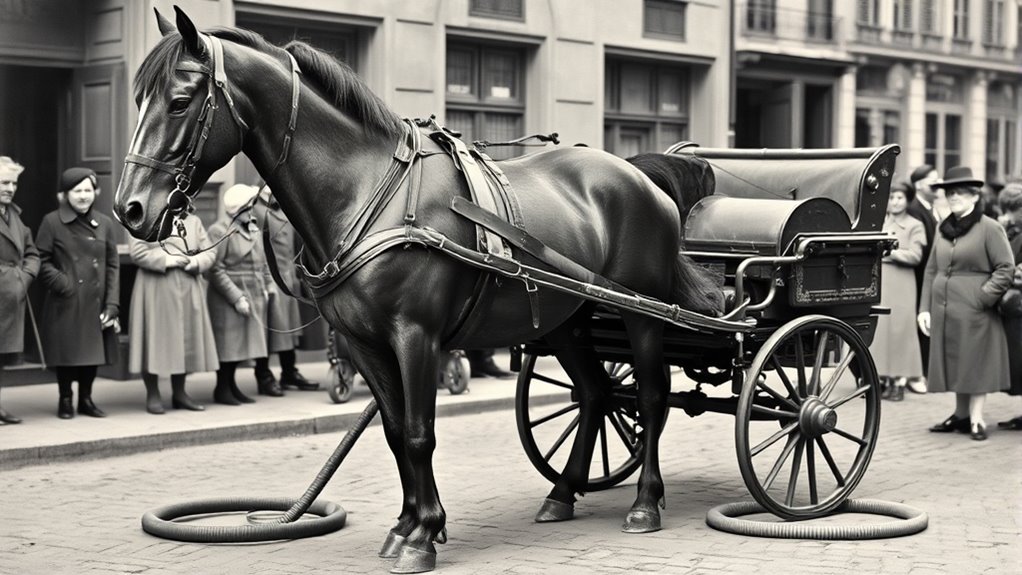
During the late 19th century, inventors experimented with horse-drawn devices to automate household chores, leading to an unlikely development: the horse-drawn vacuum. This innovation was rooted in the horsepower history, where animal-powered innovations aimed to reduce human effort. Engineers attached a large, horse-sized suction apparatus to a cart, hoping to make cleaning more efficient. The horse’s strength powered the vacuum’s suction through a system of belts and pulleys, making it one of the earliest attempts to mechanize cleaning. While it may sound bizarre today, this device showcased how animal power influenced household technology. It was an unexpected step in the evolution of vacuum cleaners, bridging manual labor and mechanization through animal-powered innovations. Inspirational quotes about fatherhood can remind us of how unexpected innovations often stem from creative thinking and collaboration.
The Rise of the Handheld and Electric Vacuums
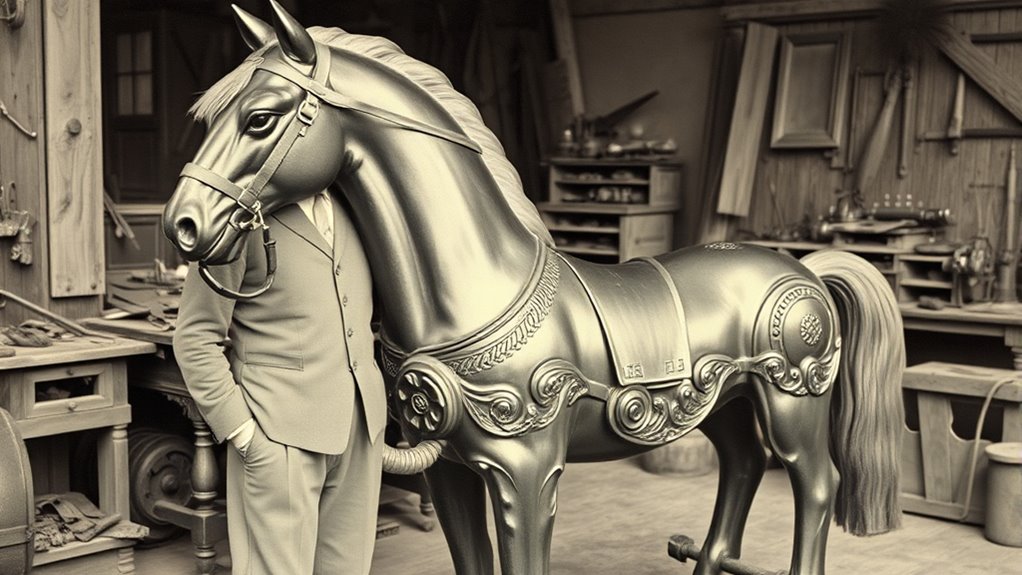
As technological advances made animal-powered devices seem outdated, inventors shifted their focus toward electric and handheld vacuums to improve household cleaning. These innovations made cleaning more convenient, lightweight, and efficient, paving the way for robotic automation in vacuum technology. Handheld models became popular for quick cleans, while electric vacuums offered more power and versatility. However, increased reliance on electric devices raised concerns about environmental impact, such as energy consumption and waste from disposable parts. Manufacturers responded by developing more sustainable designs and rechargeable batteries. The rise of these modern vacuums transformed cleaning routines, making them faster and less labor-intensive. Additionally, the integration of reclaimed wood and vintage-inspired accessories in design has influenced the aesthetic of some contemporary vacuum storage solutions. Today, their evolution continues, balancing convenience with environmental responsibility, and setting the stage for even smarter, eco-friendly cleaning solutions.
Inventors Who Shaped the Future of Cleaning Technology
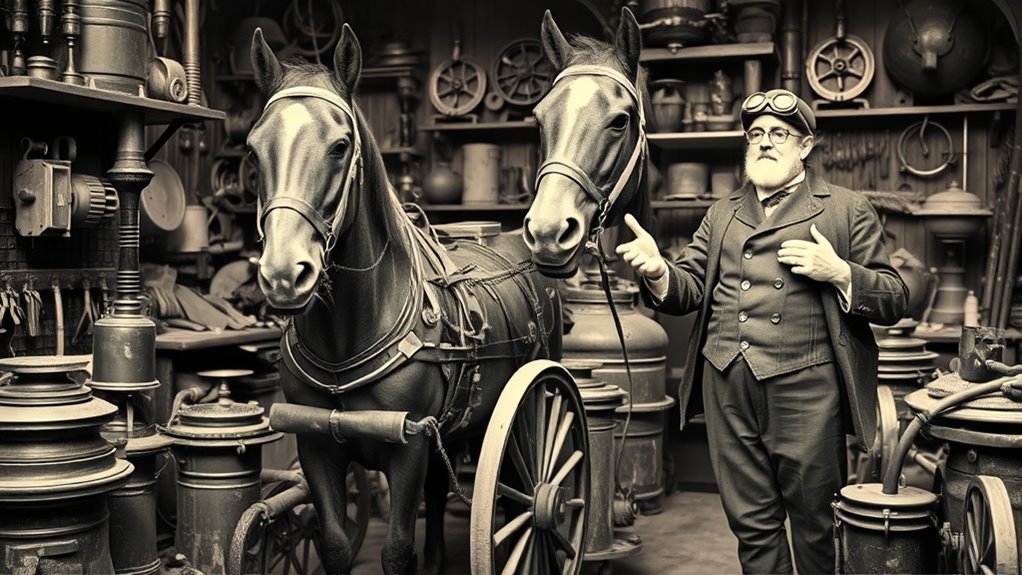
Throughout history, inventive minds have revolutionized how you maintain your home by developing groundbreaking cleaning technologies. Pioneers like James Spangler, who invented the first portable vacuum, laid the foundation. Today’s innovators focus on robotic automation, making cleaning effortless and efficient. These advancements reduce your environmental impact by improving energy efficiency and minimizing waste. The table below highlights key inventors shaping this future:
| Inventor | Contribution |
|---|---|
| James Dyson | Cyclonic technology for better suction |
| Hoover Company | Mass production and affordable models |
| Modern Engineers | Robotic vacuums that clean autonomously, reducing waste |
These inventors continue to push cleaning technology forward, making your chores smarter and greener. High efficiency vacuum designs are now integral to sustainable home cleaning solutions.
Quirky Experiments and Unexpected Discoveries
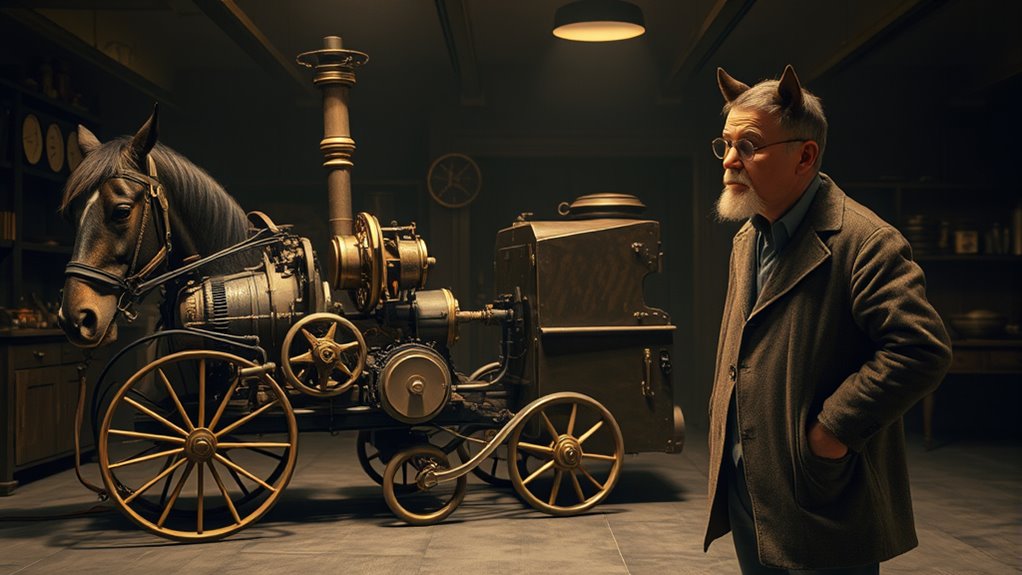
You might be surprised to learn that horsepower played an odd role in vacuum cleaner experiments. Some inventors stumbled upon key innovations by accident, not design. These unexpected moments often led to breakthroughs that changed cleaning forever. Interestingly, the concept of personality traits has also played a role in how inventors approached their work, influencing their creativity and problem-solving approaches.
Horsepower’s Unusual Role
Horsepower, a unit originally created to compare engine power, has played surprisingly quirky roles in the history of vacuum cleaners. The horsepower mythology influenced vacuum branding, with manufacturers emphasizing higher figures to suggest better performance. This led to some amusing misconceptions, like believing more horsepower meant superior cleaning—despite the fact that vacuum efficiency depends on many factors beyond raw power. In early marketing, companies exaggerated horsepower ratings to impress consumers, even when it didn’t translate to real-world results. Some experiments even used horsepower as a marketing gimmick, claiming their vacuums had “horsepower equivalents” or exaggerated power claims. These quirks showcase how horsepower’s role in vacuum history is more about perception and branding than technical accuracy. Additionally, the adoption of horsepower in marketing reflects broader trends of branding strategies that prioritize consumer perception over technical specifications.
Accidental Discovery Moments
Did some of the most surprising discoveries in vacuum cleaner history happen by accident? Absolutely. Early inventors stumbled upon key breakthroughs through quirky experiments. For example:
- A researcher noticed dust mites disappearing after a rough cleaning ritual, inspiring the idea that vacuums could target hidden allergens.
- A technician accidentally created a device that sucked up more than dust—uncovering the importance of suction power.
- An engineer’s misfire with a motor led to the first portable vacuum, revolutionizing household chores.
- A scientist’s experiment with brushes revealed how to better remove debris from carpets.
- Sometimes, integrating fin and forage principles into cleaning tools improved their efficiency and sustainability, leading to innovations in vacuum design.
These accidental moments shaped how we comprehend dust mites, cleaning rituals, and the vacuum’s evolution—proving that sometimes, mistakes lead to the biggest innovations.
Modern Vacuum Cleaners: From Simplicity to Smart Technology
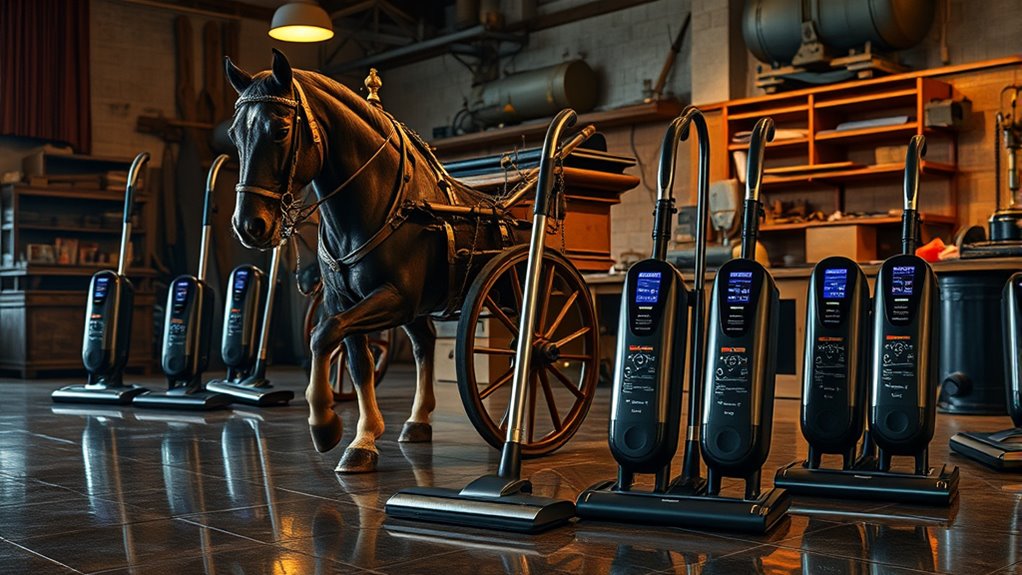
Modern vacuum cleaners have evolved from basic designs to sophisticated devices with smart features that make cleaning easier. You’ll notice how design improvements enhance usability and convenience, often with sleek, ergonomic shapes. These innovations redefine how you keep your home spotless, combining technology with user-friendly functionality. Additionally, some models now incorporate comfort solutions like adjustable settings and ergonomic handles to reduce user fatigue during cleaning tasks.
Smart Features Evolution
As technology advanced, vacuum cleaners shifted from simple, manual devices to intelligent appliances equipped with smart features. This evolution brought significant benefits, including:
- robotic automation, allowing vacuums to clean autonomously without human intervention
- improved energy efficiency, reducing power consumption while maintaining performance
- Wi-Fi connectivity, enabling remote control via smartphones
- adaptive sensors that detect dirt and adjust suction levels accordingly
- paint sprayer technology innovations that have influenced the development of smarter cleaning devices, emphasizing precision and efficiency
These smart features make cleaning more convenient and effective. Robotic automation means you can set your vacuum to clean while you’re away, and sensors help optimize cleaning paths. Energy-efficient designs ensure you save on electricity without sacrificing cleaning power. As a result, modern vacuum cleaners combine innovation with practicality, transforming household chores.
Design and Usability
The design and usability of vacuum cleaners have undergone a remarkable transformation, making them more intuitive and user-friendly than ever before. Today’s models prioritize aesthetic appeal, blending sleek looks with modern materials that complement any space. Ergonomic design plays a pivotal role, ensuring comfort during use with lightweight builds, adjustable handles, and easy-to-maneuver shapes. Controls are simplified, often integrated into ergonomic grips for quick access, reducing strain. Cordless options and compact sizes enhance portability and storage, while ergonomic features minimize fatigue. These improvements mean you can clean more efficiently, with less effort and frustration. Additionally, performance enhancements have led to more effective cleaning results while maintaining ease of use. Modern vacuum cleaners combine style and function seamlessly, transforming a once cumbersome chore into a more pleasant, accessible experience.
Frequently Asked Questions
How Did Horses Become Part of Vacuum Cleaner History?
You might find it surprising, but horses played a role in vacuum cleaner history through horse-powered, animal labor. Early vacuum cleaners, like the ‘hoods,’ used horse or other animal power to generate suction before electric models emerged. This innovative approach harnessed animal labor to assist with cleaning tasks, showcasing how humans initially relied on animals for mechanical power before developing more modern, electric-powered devices.
Were There Any Failed Vacuum Inventions Involving Animals?
Imagine animals as pioneers in mechanical mishaps, testing inventions that often failed spectacularly. You’d find many failed vacuum prototypes involving animal experiments, where creatures became unintended symbols of design flaws. These experiments, meant to improve technology, sometimes resulted in chaos or harm, highlighting the risks of innovation. Such failures remind us that even in progress, mistakes serve as lessons, shaping safer, smarter inventions for the future.
What Were the Earliest Cleaning Devices Before Vacuums?
Before vacuums, early cleaning devices focused on dust collection using simple tools like brooms, dustpans, and cloths. People relied on manual cleaning innovations, such as hand-held brushes and sweeping devices, to keep spaces tidy. These methods paved the way for more advanced cleaning technology. You can see how these innovations evolved into modern vacuums, transforming dust collection into efficient, automated cleaning systems that save time and effort.
Did Early Vacuums Have Any Connection to Other Machinery?
Think of early vacuums as cousins to horse-powered innovations, where animal-assisted cleaning played a role. These machines often connected to other machinery, like belts and gears, to boost efficiency. You’ll find that animal assistance wasn’t just for transportation but also helped power or operate parts of cleaning devices. Early engineers saw animals as essential partners in developing more effective cleaning tools, blending machinery with natural power sources seamlessly.
How Did Public Perception of Vacuum Technology Evolve Over Time?
You see, public perception of vacuum technology changed as dust collection and motor innovation improved. Early models were seen as quirky or even strange, but as they became more effective and easier to use, people grew to trust and rely on them. The advancements in motor power made cleaning faster and more efficient, helping vacuum cleaners become an essential household appliance, transforming how you maintain cleanliness over time.
Conclusion
As you imagine the evolution of vacuum cleaners, you can almost hear the clatter of horse-drawn carts giving way to sleek, humming machines. The journey from brooms to smart tech feels like a dance through time—quirky experiments, bold inventors, and unexpected twists shaping your everyday life. So next time you press that button, remember the bizarre history behind it, a story woven with horses, sparks, and relentless innovation that keeps your world spotless.
